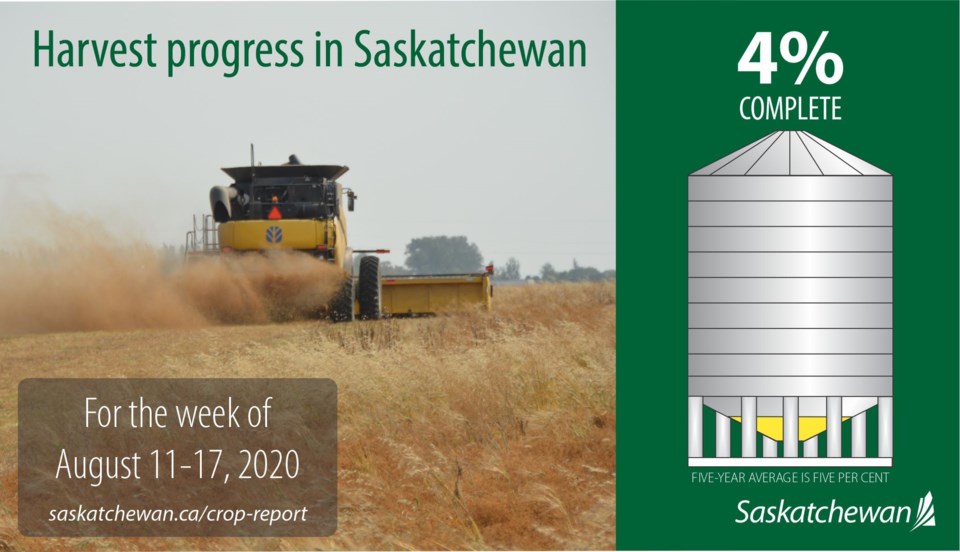Warm temperatures have continued to rapidly develop and ripen crops, with some reports of premature ripening. Four per cent of the crop has been combined, up from one per cent last week and slightly behind the five-year average (2015-2019) of five per cent for this time of year. Six per cent of the crop has been swathed or is ready to straight-cut, behind the five-year average (2015-2019) of eight per cent.
East-Central Saskatchewan:
·Crop District 5 – Melville, Yorkton, Cupar, Kamsack, Foam Lake, Preeceville and Kelvington areas
·Crop District 6A – Lumsden, Craik, Watrous and Clavet areas
Currently, two per cent of the crop is combined in the region, which is ahead of the five-year average of one per cent for this time ofyear. Five per centof the crop has been swathed or is ready to straight-cut. The five-year (2015-2019) is five per cent. High temperatures paired with dry conditions have resulted in premature ripening in some areas.
Forty-eight per cent of the fall rye, 30 per cent of the winter wheat, 18 per cent of the field peas, 11 per cent of the lentils and three per cent of the barley has been combined. An additional one per cent of the canola has been swathed.
Certain areas of the east-central region received rain this past week, with some of the eastern parts receiving half an inch to two inches. The Yorkton area receive the most rain with 53 mm. The Rhein area received 32 mm,the Langenburg area 28 mm, Rama area 23 mm, the Lipton and Goodeve areas 18 mm, the Elfros area 13 mm, the Earl Grey area 12 mm, the Allan area six mm and the Stalwart area five mm. The Kuroki area received the most precipitation in the region since April 1 with 283 mm.
Overall, topsoil moisture was maintained thisweek. Cropland topsoil moisture is rated as 36 per cent adequate, 40 per centshort and 24 per cent very short. Hay and pasture land topsoil moisture is rated as 17 per cent adequate, 50 per cent short and 33 per cent very short. Crop District 6A reported that 86 per cent of the cropland and 97 per cent of the hay and pasture land has a topsoil moisturerating of short or very short.
The majority of crop damage this week was due to dry conditions, heat and wind. There have also been reports of localized hail in the region.
Farmers are busy hauling grain, getting equipmentand bins ready for harvest and starting to swath, desiccate and combine in some areas.
Provincially
Sixty-two per cent of fall rye, 37 per cent of winter wheat, 22 per cent of field peas, 19 per cent of lentils and six per cent of barley has been combined. An additional three per cent of canola has been swathed or is ready to straight-cut.
Eleven per cent of the crop in the southwest region has been combined, five per cent in the southeast, two per cent in the central regions and less than one per cent in the northern regions. Some farmers in the northern regions have started to desiccate and swath earlier seeded crops and many more plan to in the next few weeks.
Most of the province received trace amounts of rainfall this week. Areas near Glenavon received the highest amount with 77 mm. Some rain was reported in parts of the eastern crop districts of the east-central and southeast regions. Most of the rest of the province received anywhere from zero up to 13 mm of rain. Rain is not needed in near-mature or ready-to-harvest crops, but some later-seeded crops and pastures would benefit from more moisture.
Moisture conditions declined throughout most of the province this week, except for areas in the southeast and east-central regions that received rain. Cropland topsoil moisture is rated as 44 per cent adequate, 39 per cent short and 17 per cent very short. Hay and pasture land topsoil moisture is rated as 33 per cent adequate, 42 per cent short and 25 per cent very short.
Crop damage causes this week remain the same with the majority caused by wind, heat, lack of moisture, wildlife and insects such as grasshoppers. There have been some reports of flea beetle damage in canola, as well as localized hail damage.
Farmers are busy getting equipment and bins ready for harvest, swathing and desiccating crops, and combining. With harvest underway in Saskatchewan, we want to remind producers to exercise caution and remain safe.
A complete, printable version of the Crop Report is available online at www.saskatchewan.ca/crop-report.
Follow the 2020 Crop Report on Twitter at @SKAgriculture.

